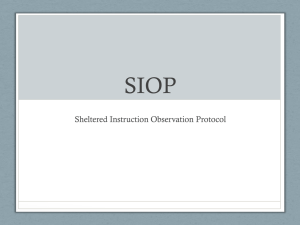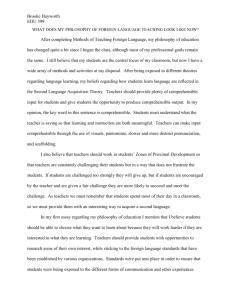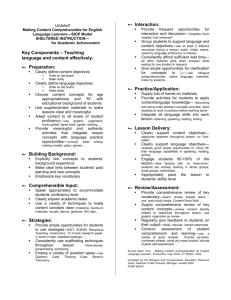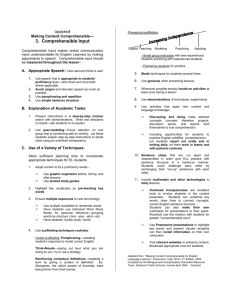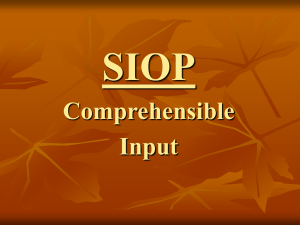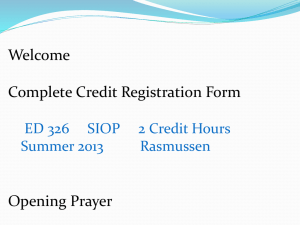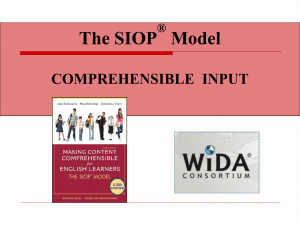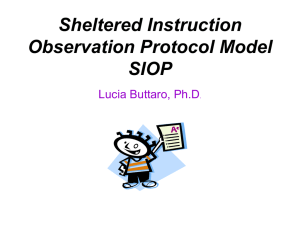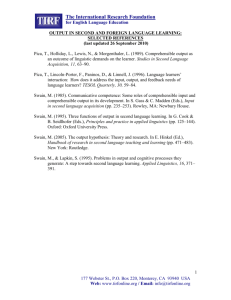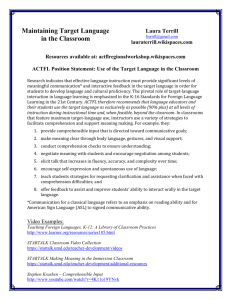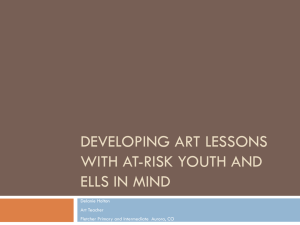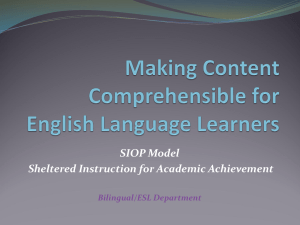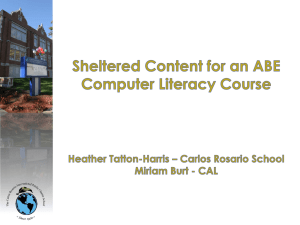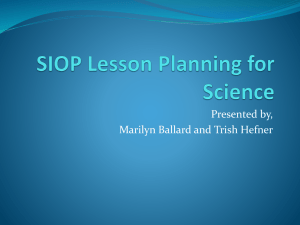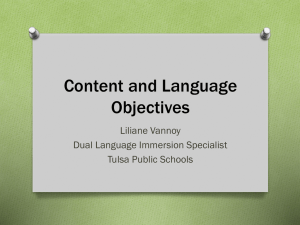Component 3-Comprehensible Input
advertisement
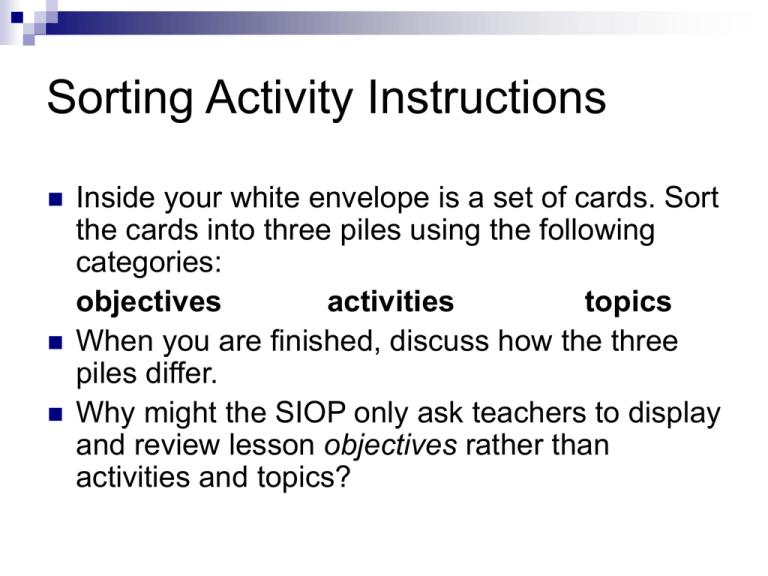
Sorting Activity Instructions Inside your white envelope is a set of cards. Sort the cards into three piles using the following categories: objectives activities topics When you are finished, discuss how the three piles differ. Why might the SIOP only ask teachers to display and review lesson objectives rather than activities and topics? SIOP Component 3: Comprehensible Input SIOP Component 3: Comprehensible Input Content Objective(s): Explore techniques for presenting content information in ways that students comprehend Review various ways to model and provide directions for academic tasks Language Objective(s): Discuss and sort the following into groups: objectives, activities, & topics Listen to a story and follow the directions Discuss modifications to teacher speech that can increase student comprehension “The Wright Family” • How did this activity make you feel? What did your group do? • Who can tell me what the story was about? Why or why not? • If the goal was comprehension, what could I have done differently? • Do our activities support learning outcomes? SIOP Component 3: Comprehensible Input F10: Speech is appropriate for students’ proficiency level (e.g. slower rate, enunciation, and simple sentence structure for beginners). F11: Clear explanation of academic tasks. F12: Use a variety of techniques to make content concepts comprehensible (e.g. modeling, visuals, hands-on activities, demonstrations, gestures, and body language). Speech is appropriate for students’ proficiency level Rate and enunciation How the teacher speaks Complexity of speech What the teacher says Adjust “Teacher Talk” Face the students Pause frequently Paraphrase often Speak slower if necessary Emphasize important ideas Avoid “asides” User shorter sentences Wait time Meaning emphasized (not grammar) Avoid interpreting Helping with Comprehensible Input Homophones (sound the same, different spellings, different meaning) there, their, & they’re to, too, & two sale & sail Homographs (spelled the same, different sound, different meaning) bow & bow wound & wound Homonym (spelled the same, sound the same, different meaning) Duck and duck Bat and bat Synonyms (different words, same meanings) Idioms (popular saying or cliché where the literal meaning does not match the figurative meaning) Idioms A distinctive expression whose meaning cannot be deduced from the combined meaning of its individual words. Often unique to a culture or group of people. Interaction with a new student – A behavior problem “Freeze!” I want to talk to you. “I know that you’re the new kid on the block and perhaps you don’t know the ropes yet, but you are off the wall and need to straighten up. You’ve only been here a month but it is time to face the music; you are digging yourself a hole that I am not sure you can get out of. You did not start here with your best foot forward and I can see the writing on the wall. If you’re just getting along by the skin of your teeth now, there is no way that I will turn a blind eye. So, let’s go back to square one. Put on your thinking cap and figure out how you should behave before I pull the plug on you here.” Cognates A word with similar pronunciation and meaning in multiple languages. False Cognates A word with similar pronunciation but different meaning in multiple languages. Comprehensible Input – Ask Yourself . . . Is my speech appropriate for the proficiency level of my students? Do I avoid jargon and idioms? Do I present instructions step-by-step? Do I use peer-modeling? Do I paraphrase and restate student’s responses (modeling correct English)? Comprehensible Input – Ask Yourself . . . Do I use think-alouds? Do I reinforce definitions in context? Do I use a variety of question types? Do I use a variety of grouping structures in a class (pair, triad, team)? Do I vary group members from day-to-day? Comprehensible Input – Ask Yourself . . . Do I give students enough wait time? Do I allow students to confer with each other (in their L1 if necessary) to clarify concepts? Do I use hands-on activities to help students make abstract concepts concrete? Comprehensible Input – Ask Yourself . . . Do I include opportunities for students to read, write, listen, and speak? Do I continually include vocabulary review in daily work? Do I use a variety of methods to elicit group responses? SIOP Component 3: Comprehensible Input Content Objective(s): Explore techniques for presenting content information in ways that students comprehend Review various ways to model and provide directions for academic tasks Language Objective(s): Discuss and sort the following into groups: objectives, activities, & topics Listen to a story and follow the directions Discuss modifications to teacher speech that can increase student comprehension

